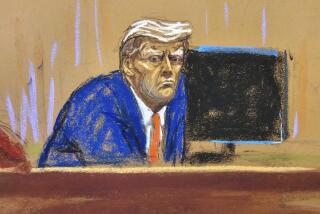Should Hidden Cameras Be Used for TV News? : Television: Questions are raised over a judge’s order preventing ‘Inside Edition’ from showing secretly obtained footage.
NEW YORK — Do TV reporters have the same right to investigate a story by going undercover with a hidden camera that print reporters do when they take a notebook and pen with them? And, more important, does a judge have the right to prevent TV producers from airing footage they’ve shot?
Those are the key issues in a legal case involving the syndicated magazine series “Inside Edition,” which has been blocked from broadcasting footage of a New York physician that was obtained by a producer who posed as a patient.
Beyond raising questions about hidden-camera interviews, the case may be the first time that a judge has successfully imposed prior restraint on a nationally televised series.
U.S. District Court Judge Barbara Hackett ruled in Detroit that “Inside Edition” violated the federal wiretapping law by obtaining the sequence with Dr. Stuart Berger in his office without his “consent or knowledge.” She issued a temporary restraining order preventing the airing of the hidden-camera interview.
“Inside Edition’s” report on Berger, a New York physician and best-selling diet-book author whose nutrition therapies have been controversial, aired Monday, but without the hidden-camera segment that had been obtained by producer Amy Wasserstrom. She visited the doctor’s office three times, posing as a patient seeking his medical advice.
“This is an unprecedented violation of the First Amendment,” Martin Garbus, the attorney representing King World, the producer-distributor of “Inside Edition,” said in an interview. “What is at issue here is whether a judge can stop a segment of a TV show. Prior restraint of publication is not permitted under the Constitution except on grounds of national security. If the courts did not stop The New York Times from publishing ‘The Pentagon Papers,’ there is no basis at all for stopping someone who walks in with a hidden camera and tapes an interview.”
According to Berger’s lawyers, the producers were trespassing on his private property.
“They basically defrauded him into letting this woman come into his office,” Russell Ethridge, the Detroit attorney representing Berger, said in an interview. “He would not have let them in otherwise. They can say anything they want to about Dr. Berger in their reporting. What we’re trying to do is restrain their use of the fruits of an illegal act.”
Executives at King World, the company that produces and distributes “Inside Edition,” take a different view of what transpired.
“Investigative reporters for years have gone undercover in order to get at the facts of a story, particularly facts that someone wants to conceal,” said Av Westin, a King World vice president and executive producer of the series. “What has happened now in TV journalism is that TV equipment has gotten small enough and light-sensitive enough to do what is standard in print journalism, where a reporter can go in with his notebook and write down his recollections.”
In both print and broadcast journalism, reporters do not usually go undercover to get their story. But according to Westin, who formerly produced ABC’s “20/20,” the technique has been used on that program and on other network news magazines.
Attorney Ed Rosenthal, who argued the case for King World, maintained that what Wasserstrom did is not illegal according to New York state law, which allows such taping if one of the parties consents to the act.
Ethridge contended that the federal wiretap law was violated and that the notion of one-party consent does not apply because of the way the interview was obtained.
King World is appealing the decision and asking that the case be moved to New York, where Berger practices and “Inside Edition” is produced. Berger’s lawyers said that he brought the case in Detroit because he also has business dealings there.
A hearing on continuing the temporary restraining order is scheduled for next week.
“Inside Edition” hopes to do a follow-up segment on Berger that would include the disputed footage.
The “Inside Edition” segment that aired Monday contained interviews with several doctors who questioned Berger’s methods. Berger, whose theories have generated controversy in the medical community, is under investigation by the New York State Health Department Office of Professional Medical Conduct.
Although the hidden-camera interview was not shown, producer Wasserstrom gave an account of what she said happened during her visit to the doctor’s office.
Network news executives said on Wednesday that they had not yet been able to review the “Inside Edition” case for comment.
More to Read
The complete guide to home viewing
Get Screen Gab for everything about the TV shows and streaming movies everyone’s talking about.
You may occasionally receive promotional content from the Los Angeles Times.






